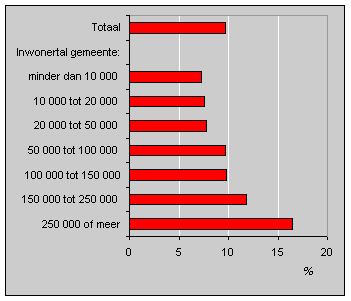Minium incomes mainly in large cities and the north

In 1999 one in ten households in the Netherlands had an income at or around the level of the social minimum. Relatively many of these households live in the large cities and in the provinces Groningen and Friesland.
Large cities
In 1999 nearly ten percent of households in the Netherlands had to get by on a minimum income. The more inhabitants a municipality has, the higher the proportion of households with a minimum income is. Most minimum income households live in municipalities with 250 thousand or more inhabitants: Amsterdam, Rotterdam and The Hague. In these cities, one in six households receives a minimum income.
Households with a minimum income by population of municipality, 1999

In addition to the three largest cities, Groningen, Arnhem, Nijmegen, Utrecht, Dordrecht, Tilburg and Eindhoven also had more minimum income households than average. Relatively many households in large cities are dependent on a disablement or unemployment benefit or on income support. Moreover, many single people live in large cities, a category which also comprises a lot of people with a minimum income.
The north
Roughly speaking, the national distribution of households shows the following picture. Many municipalities in the north of the country have a larger share of minimum households than the national average. With the exception of the city of Groningen the highest percentages of minimum incomes were in the municipalities of Harlingen, Leeuwarden, Reiderland and Winschoten.
Many municipalities in the west of the country on the other hand have a low percentage of minimum income households. Most municipalities in the east and the south of the country are in an intermediate position, with the proportion of low income households just under the national average.
Petra Ament